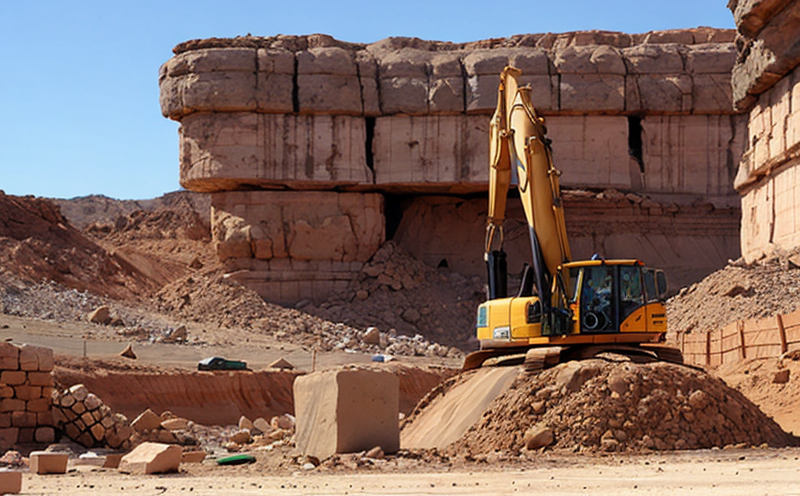ISRM Suggested Method for Point Load Testing of Rocks
The International Society for Rock Mechanics (ISRM) has provided a standardized methodology for point load testing rocks through its suggested methods. This method is widely recognized and used in the mining sector to evaluate the mechanical properties of rock samples, particularly their strength under uniaxial compression.
Point Load Testing (PLT) is an essential technique employed by quality managers, compliance officers, R&D engineers, and procurement teams to assess the integrity and stability of rocks used in various construction projects. PLT measures the resistance of a cylindrical rock sample to crushing forces applied at its ends. This test provides insights into how well rocks can withstand stress without fracturing under real-world conditions.
The ISRM method specifies stringent procedural guidelines for conducting point load tests, ensuring accurate and reproducible results. These procedures include selecting appropriate specimen sizes, maintaining consistent loading rates, and applying precise measurement techniques to record the force required to cause failure within a sample. Compliance with these standards guarantees reliable data that can be relied upon by stakeholders.
Rock mechanics plays a crucial role in mining operations, influencing decisions related to excavation design, support systems installation, and overall project safety. By leveraging ISRM’s point load testing protocol, organizations ensure they are adhering to industry best practices. This not only enhances operational efficiency but also contributes significantly towards achieving regulatory compliance.
For instance, when designing underground tunnels or open-pit mines, understanding the compressive strength of surrounding rock formations is vital for predicting potential failures and safeguarding worker safety. Using ISRM’s point load testing method allows engineers to gather accurate information about these rocks’ behavior under stress before commencing any construction activities.
In addition to providing valuable insights during initial planning stages, regular monitoring through periodic retests helps monitor changes in rock properties over time due to environmental factors like weathering or human intervention. Such continuous assessment ensures ongoing safety and efficiency throughout the lifecycle of mining projects.
It is important for those involved in mineral exploration and extraction to understand that while ISRM’s point load testing method offers numerous benefits, it does require careful execution by trained personnel equipped with suitable equipment. Proper specimen preparation, adherence to loading protocols, accurate force measurement, and correct interpretation of results are key elements contributing to successful outcomes.
By adopting this standardized approach, mining companies can enhance their decision-making processes while ensuring compliance with relevant regulations. This ultimately leads to safer operations, reduced risk of accidents, improved productivity, and long-term sustainability in the industry.
Why It Matters
Understanding rock mechanics is crucial for effective mine planning and operation. Rock properties significantly influence factors such as excavation stability, tunnel support design, and overall safety measures implemented within mining environments. Point load testing serves as a critical tool in assessing these characteristics accurately.
- Excavation Stability: Knowing the compressive strength of rocks helps predict whether they will remain stable during excavation processes or if special supports are needed to prevent collapse.
- Tunnel Support Design: Engineers can design appropriate support systems based on rock properties obtained from point load tests, ensuring safe passage for personnel and equipment through tunnels.
- Safety Measures: Reliable information about rock behavior under stress aids in establishing necessary safety protocols to protect workers from hazards associated with unstable ground conditions.
The significance of accurate rock property assessment extends beyond immediate mining activities; it also impacts secondary operations like rehabilitation and reclamation efforts. By ensuring that the chosen methods are reliable and repeatable, stakeholders can trust the results generated by point load testing.
Moreover, compliance with international standards such as ISRM ensures consistency across projects worldwide. This uniformity facilitates better communication among professionals involved in different phases of mining operations, fostering collaboration and innovation within the sector.
Eurolab Advantages
Eurolab is committed to delivering high-quality services that meet or exceed industry expectations. Our state-of-the-art facilities equipped with advanced instrumentation allow us to perform precise point load tests according to ISRM guidelines consistently and accurately.
- Accurate Results: Leveraging experienced technicians and sophisticated equipment, we ensure accurate force measurements and reliable data collection.
- Comprehensive Reporting: Our comprehensive reports provide detailed analysis of each test conducted, including raw data and interpreted findings. This enables stakeholders to make informed decisions promptly.
- Rapid Turnaround Times: By optimizing our processes, we aim to deliver results quickly without compromising accuracy or thoroughness.
- Compliance Assurance: Our adherence to international standards ensures that all tests meet the required specifications, providing peace of mind for clients.
In addition to technical excellence, Eurolab offers exceptional customer service. We understand the importance of timely communication and strive to maintain open lines of dialogue throughout each project phase. This approach fosters trust between us and our clients, ensuring long-term partnerships built on mutual respect and satisfaction.
Our commitment to quality is reflected not only in our technical capabilities but also in our dedication to continuous improvement. By staying abreast of the latest developments within the field and incorporating them into our practices, Eurolab remains at the forefront of rock mechanics research and application.





